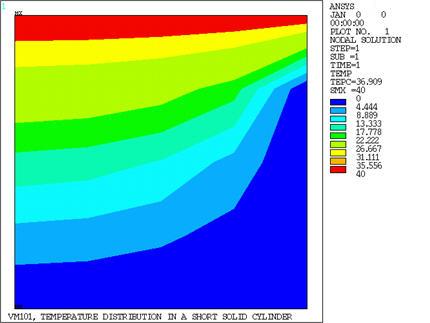VM101
VM101
Temperature Distribution in a Short Solid Cylinder
Test Case
A short solid cylinder is subjected to the surface temperatures shown. Determine the temperature distribution within the cylinder.
| Material Properties | Geometric Properties | Loading | ||||
|---|---|---|---|---|---|---|
|
|
|
Analysis Assumptions and Modeling Notes
Since the problem is axisymmetric only a sector (one element wide) is modeled. A small angle Θ=10° is used for approximating the circular boundary with a straight-sided element. Note that circumferential symmetry is automatically ensured due to default adiabatic boundary conditions. POST1 is used to report centerline and mid-radius temperatures to compare results.
Results Comparison
| Target[1] | Mechanical APDL | Ratio | ||
|---|---|---|---|---|
|
T, °F
(centerline) | Node 11 | 6.8 | 7.4 | 1.09 |
| Node 21 | 15.6 | 16.4 | 1.05 | |
| Node 31 | 26.8 | 27.4 | 1.02 | |
|
T, °F (mid-radius) | Node 13 | 5.2 | 5.3 | 1.02 |
| Node 23 | 12.8 | 13.0 | 1.02 | |
| Node 33 | 24.0 | 24.8 | 1.03 | |



